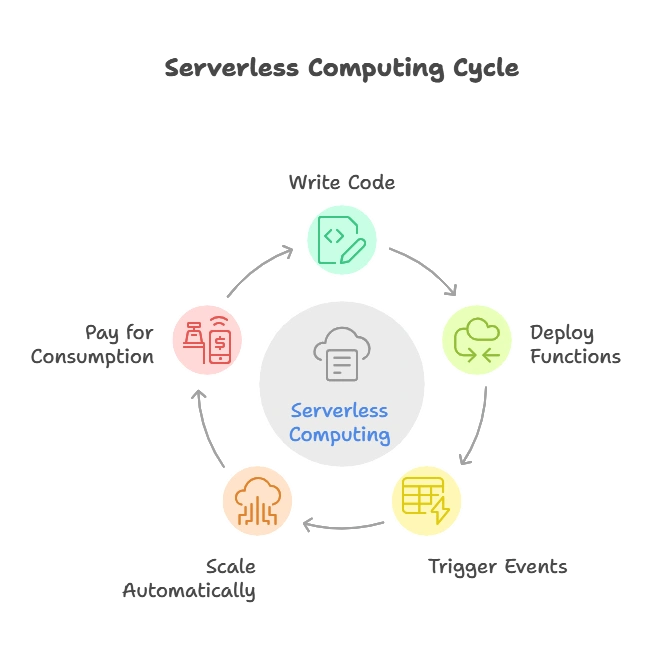Serverless Computing with Node.js (AWS Lambda, Google Cloud Functions, etc.)
Serverless computing is a revolutionary approach to running applications where you don’t manage any infrastructure. Instead of deploying code on traditional servers, you deploy on cloud provider platforms, such as AWS Lambda, Google Cloud Functions, or Azure Functions.
Introduction to Serverless Computing
Serverless computing is a cloud computing model where the cloud provider manages the server and infrastructure. Developers only write code and define functions, which are deployed as isolated units that automatically scale based on demand.
In serverless:
- No need to manage server instances.
- Pay only for the resources consumed during function execution.
- Functions can be triggered by various events (HTTP requests, database updates, file uploads, etc.).

Advantages of Serverless Computing
- Scalability: Automatic scaling based on the incoming load.
- Cost Efficiency: Pay-as-you-go pricing based on function execution time, reducing costs for infrequently used applications.
- Reduced Operational Overhead: No need to manage servers, patches, or hardware concerns.
- Quick Development Cycle: Focus solely on coding, leading to faster deployments.
Core Concepts in Serverless Computing
Serverless functions in Node.js operate around the following concepts:
- Function as a Service (FaaS): The fundamental unit of serverless is the function that performs a specific task.
- Event-Driven Architecture: Functions are triggered by events, such as HTTP requests, file uploads, or scheduled timers.
- Ephemeral Instances: Each function call is independent, which means no persistent data storage within the function’s instance.
Popular Serverless Platforms
- AWS Lambda: Highly popular, supports Node.js and offers integration with other AWS services.
- Google Cloud Functions: Integrates well with Google services and supports various Node.js versions.
- Azure Functions: Part of Microsoft Azure, supporting Node.js and integration with Microsoft cloud services.
Setting up Serverless Functions in AWS Lambda
Step 1: Creating an AWS Lambda Function in Node.js
- Log into your AWS Console and go to AWS Lambda.
- Choose Create Function and set:
- Function Name: A descriptive name for your function.
- Runtime: Node.js (select the appropriate version).
- In Function Code, write a simple handler function.
Example Code for AWS Lambda
// index.js
exports.handler = async (event) => {
const name = event.queryStringParameters && event.queryStringParameters.name || "World";
const response = {
statusCode: 200,
body: JSON.stringify(`Hello, ${name}!`),
};
return response;
};
Explanation:
handleris the main entry point for AWS Lambda.event.queryStringParametersallows access to HTTP query parameters.
Output: If accessed via a URL like https://.../lambda-function?name=Alice, it responds with Hello, Alice!.
Step 2: Configuring API Gateway for HTTP Access
AWS Lambda functions can be exposed via HTTP endpoints using API Gateway.
- Create an API in API Gateway and link it to your Lambda function.
- Set the API Gateway method to
GET. - Deploy the API and note the generated URL, which can trigger the function.
Step 3: Testing the Lambda Function
Test the endpoint URL in your browser or via curl:
curl https://.../lambda-function?name=Bob
This will invoke the Lambda function and return a JSON response.
Setting up Serverless Functions in Google Cloud Functions
Step 1: Setting up Google Cloud Project
- Go to the Google Cloud Console and create a new project.
- Enable Cloud Functions API for your project.
Step 2: Deploying a Function
- In the Cloud Functions dashboard, select Create Function.
- Set the following:
- Function Name: A descriptive name.
- Runtime: Node.js (choose a compatible version).
- Trigger: Choose HTTP.
Example Code for Google Cloud Function
// index.js
exports.helloWorld = (req, res) => {
const name = req.query.name || "World";
res.status(200).send(`Hello, ${name}!`);
};
Explanation:
- This code uses Express-like syntax where
reqandresrepresent the HTTP request and response objects. req.queryallows reading query parameters.
Output: Accessing the function URL https://...cloudfunctions.net/helloWorld?name=Dave will return Hello, Dave!.
Step 3: Testing the Function
Use curl to test:
curl https://...cloudfunctions.net/helloWorld?name=Carol
Best Practices for Serverless Development
- Optimize Cold Starts: Minimize dependencies and avoid heavy initialization in your functions to reduce cold start times.
- Use Environment Variables: Store configuration details like API keys outside of code.
- Handle Errors Gracefully: Implement error handling to ensure that issues don’t break the function execution.
Challenges and Limitations of Serverless Architecture
- Cold Starts: First-time function executions may be slow, especially with large dependencies.
- Statelessness: Each function execution is isolated; state needs to be managed in external storage.
- Vendor Lock-In: Migrating functions across platforms can be challenging due to vendor-specific configurations.
Serverless computing offers a scalable, cost-effective way to run Node.js applications in the cloud. With AWS Lambda, Google Cloud Functions, and similar platforms, developers can focus on coding, not server management. Serverless is especially effective for event-driven applications, APIs, and backend tasks, where resources are only consumed when needed. By understanding the nuances of each platform and employing best practices, developers can leverage serverless to build resilient and scalable Node.js applications. Happy Coding!❤️
